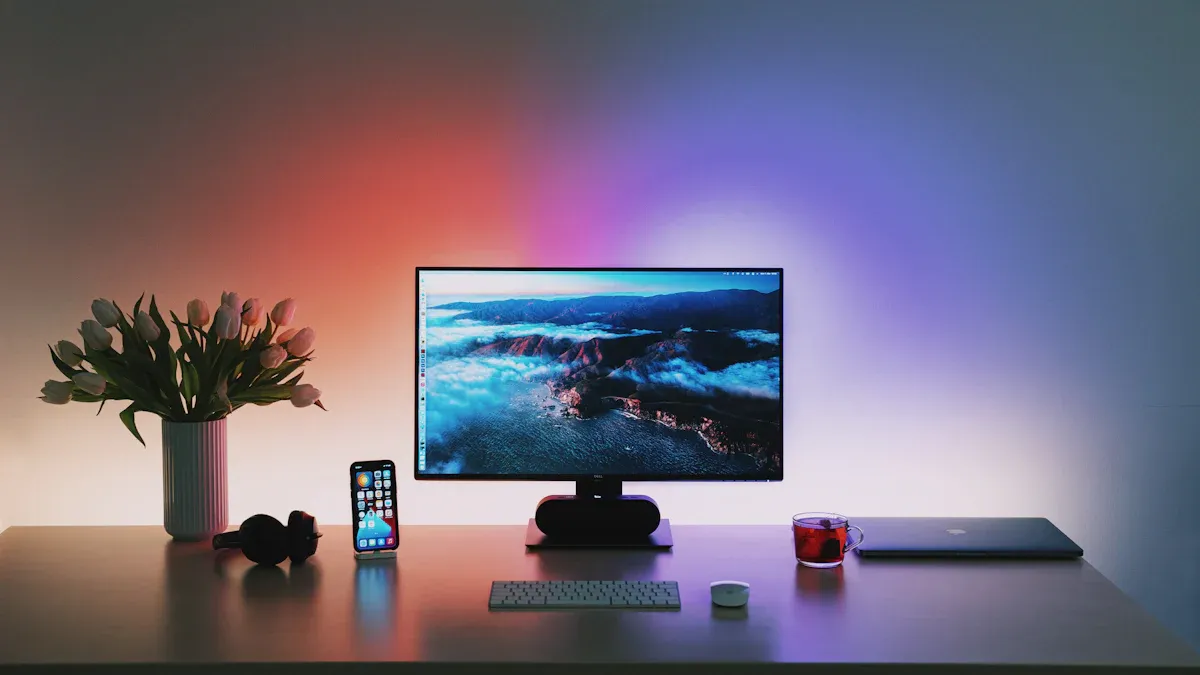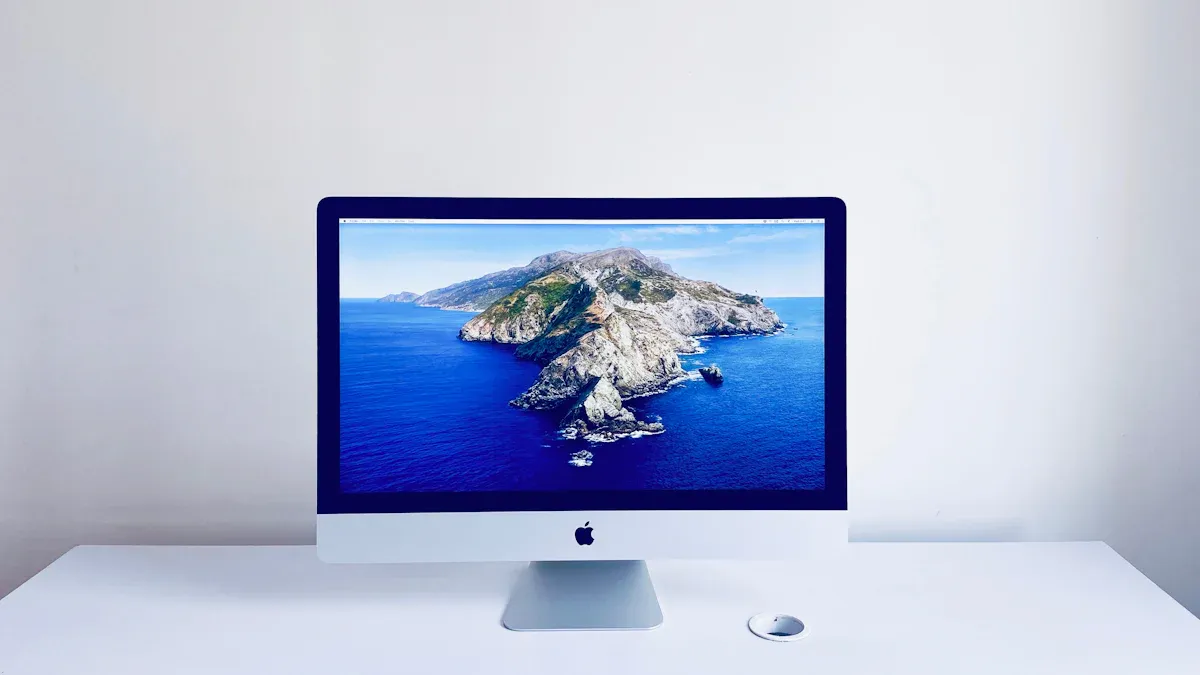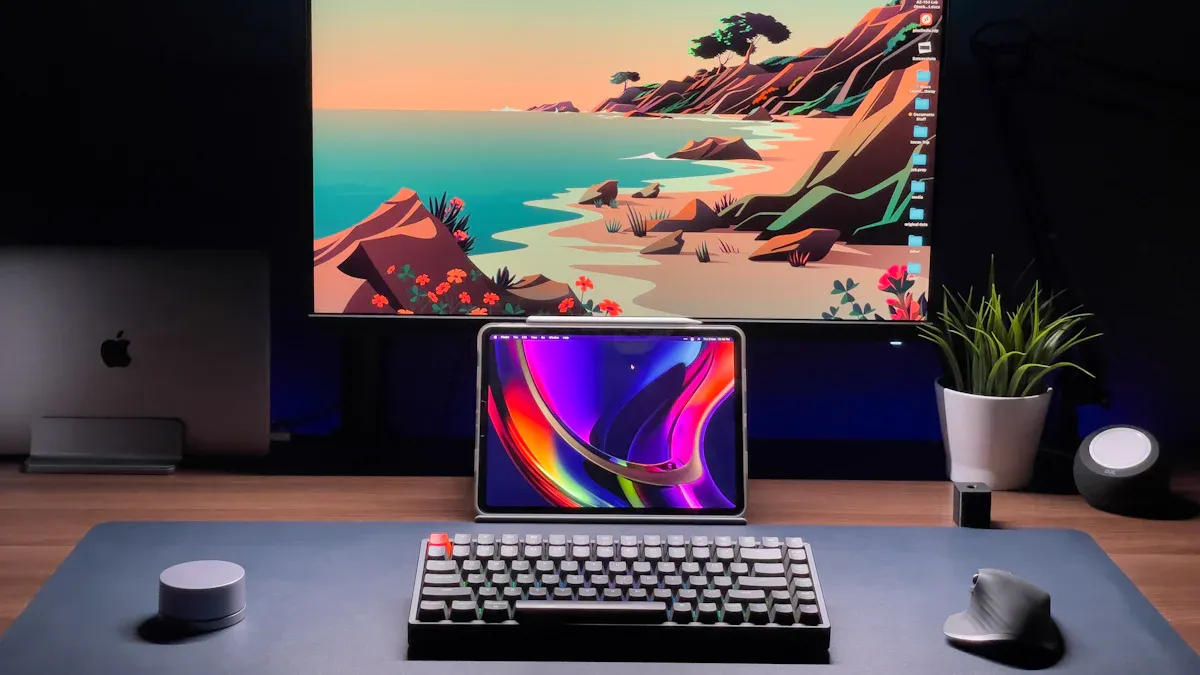
Picking the right computer can seem hard, but it’s not. All-in-one computers mix power, style, and ease in one device. Whether you work, play games, or surf online, picking one that suits you matters. Want to make choosing easier? Let’s begin.
l Think about what you need the computer for. Decide if it’s for work, games, or fun to choose the right one.
l Pick the operating system that works best for you. macOS is easy to use, Windows is flexible, and Chrome OS is cheaper for simple tasks.
l Pay attention to the screen size and quality. Clear screens like 4K look great, and big screens help with gaming and doing many things at once.
Picking the best all-in-one computer starts with knowing your needs. Whether it’s for work, gaming, or watching movies, understanding how you’ll use it helps. Let’s look at the details.
If you need a computer for work, choose one that’s dependable. All-in-one computers for work are great for multitasking and teamwork.
l Multitasking: These computers let you run many apps at once. You can easily switch between emails, video calls, and editing documents.
l Collaboration: Good webcams and microphones make online meetings easier.
l Focus: A fast processor helps you finish tasks quickly without delays.
For work setups, find tools to compare performance on different platforms. Some systems let you save results as Excel or PDF files to track your work better.
Gamers and heavy users need computers that handle tough tasks. While desktops are stronger, high-end all-in-ones can still perform well.
l Desktops stay cooler during long gaming sessions, keeping performance steady.
l All-in-ones don’t allow much customization but save space with their design.
l For video editing or 3D work, pick an all-in-one with a dedicated GPU for better results.
Remember, all-in-ones are flexible but may not match a fully upgraded desktop’s power.
If you love movies or music, all-in-one computers are a great pick. They have big screens and strong speakers, perfect for entertainment.
l Choose models with 4K resolution for amazing picture quality.
l Touchscreens make creative tasks like photo editing more fun.
l Built-in speakers with surround sound improve your experience.
Whether streaming shows or editing photos, these computers make multimedia tasks easy and enjoyable.
For simple tasks like browsing or social media, you don’t need high-end specs. All-in-one computers for daily use are budget-friendly and simple to set up.
l Small models fit in tight spaces like dorms or kitchens.
l Basic processors and graphics work fine for casual activities.
l These computers often include easy-to-use features and pre-installed apps.
For everyday needs, focus on ease and affordability. You’ll get a device that works well without spending too much.
Picking the right operating system (OS) is very important. It affects how well your computer works for tasks like gaming or work. Each OS has special features. Let’s look at them to help you choose.
If you want a smooth and easy-to-use system, try macOS. Apple’s OS is known for being simple and reliable. It’s great for creative people and those who like user-friendly designs.
l High Satisfaction: About 60% of workers prefer Macs for their ease of use.
l Top Performance: Apple computers are fast and dependable in many tests.
l Quality Assurance: Apple is famous for making high-quality products, says Consumer Reports.
macOS works well with other Apple devices. If you already use Apple products, this is a good choice.
Windows is a flexible OS that works for many tasks. It’s great for gaming, working, or just browsing. Most all-in-one computers use Windows, so it’s a popular option.
l Software Options: Windows supports many apps, from games to work tools.
l Hardware Variety: You can pick from many brands and setups to fit your needs.
l Gaming Power: Many games run best on Windows, making it ideal for gamers.
If you need an OS that does almost everything, Windows is a great pick.
Chrome OS is a good choice if you’re on a budget. It’s simple, fast, and great for basic tasks like streaming or browsing. Schools often use it because it’s affordable.
Device Type | Average Price Range |
Chromebooks | $200 - $500 |
Windows/Mac OS | $1,100+ |
l Cost-Effective: Chromebooks are cheaper, costing about half as much as others.
l Education-Friendly: Schools like Chrome OS for student programs, giving everyone access.
If you want a low-cost computer for everyday tasks, Chrome OS is a smart choice.

The screen is a key part of all-in-one computers. It affects how you use and enjoy the device. Let’s explore the details.
Resolution shows how clear the screen looks. HD (720p) works for simple tasks like browsing. Full HD (1080p) is better for movies or photo editing. For amazing visuals, choose 4K or higher. These are great for gaming or design work. Higher resolutions cost more, so pick what fits your budget.
Touchscreens let you tap and swipe directly on the screen. They’re great for drawing or zooming. Non-touchscreens work better with a mouse and keyboard. Here’s a comparison:
Feature/Aspect | Touchscreen All-in-One | Non-Touchscreen Display |
Host Integration | Works alone as a computer | Needs extra equipment to function |
Application Scenarios | Good for fixed uses like kiosks | Best for setups with existing systems |
Cost-Effectiveness | Cheaper for basic needs | Better for high-performance tasks |
Touchscreens are fun for creative tasks or casual use. Non-touchscreens are better for heavy-duty work.
Screen size depends on your space and needs. Small screens (21-24 inches) fit tight spaces and work well for daily tasks. Bigger screens (27 inches or more) are great for multitasking or gaming. Designers and gamers often prefer larger displays.
Tip: Measure your desk before buying a screen. Make sure it fits your space!
Choosing the right all-in-one computer depends on its performance. Whether you’re working, gaming, or streaming, the parts inside matter. Let’s look at the key features to focus on.
The processor is like your computer’s brain. It handles tasks and calculations. Picking the right one is important. The main options are Intel, AMD, and Apple Silicon. Each works best for different needs.
l Intel: Great for multitasking and everyday use. It uses more power than Apple Silicon.
l AMD: Popular with gamers and creators. It’s great for video editing and 3D work.
l Apple Silicon: Apple’s M-series chips are fast and efficient. They’re perfect for creative tasks like photo editing.
Here’s a quick comparison of popular processors:
Processor Type | Single-Core Speed | Multi-Core Speed | Power Use |
Apple M3 | Best in single-core | Beats most others | Very efficient |
Intel Core Ultra 7 | Slower than M3 | Trails M2 Max | Uses more power |
AMD Ryzen 7 | Similar to Intel | Slightly slower | Moderate efficiency |
Tip: For heavy multitasking or creative work, pick Apple Silicon or AMD. For simple tasks, Intel is a solid choice.
RAM helps your computer run multiple tasks at once. More RAM means smoother performance, especially with many apps open.
l 4GB: Good for basic tasks like browsing or writing.
l 8GB: Works well for students and most professionals.
l 16GB or more: Best for gamers or people using demanding software.
If unsure, choose 8GB. It balances cost and performance well.
Storage decides how much data your computer can hold and how fast it works. You’ll pick between SSDs and HDDs. Here’s how they compare:
Storage Type | Read Speed | Write Speed | Capacity Range |
HDD | 80 MB/s | 160 MB/s | 250GB to 14TB |
SSD | 200 MB/s | 550 MB/s | 250GB to 4TB |
NVMe m.2 | 5000-7300 MB/s | 5000-6350 MB/s | 500GB to 4TB |
l HDD: Cheaper with more space but slower and less durable.
l SSD: Faster and more reliable. Great for quick startups and app loading.
l NVMe: The fastest option, ideal for gamers and professionals needing speed.
Note: Most all-in-one computers use SSDs. They offer a good mix of speed and storage.
Graphics are important for gaming, video editing, and 3D modeling. You’ll choose between integrated and dedicated GPUs.
GPU Type | Performance Level | Power Use | Best For |
Integrated Graphics | Lower | Very efficient | Everyday tasks, budget users |
Dedicated Graphics | Higher | Less efficient | Gamers, designers, and professionals |
l Integrated GPUs: Built into the processor. Great for casual use and save energy.
l Dedicated GPUs: Separate components for heavy tasks. Perfect for gamers and designers.
Pro Tip: If you don’t game or design, integrated graphics are cheaper and work well.
When picking an all-in-one computer, ports and connections are important. They decide how useful your computer will be. Let’s explore the main features to check.
Most computers have USB ports, but they’re not all alike. Here’s a simple guide:
l USB-C: This small port works with many USB versions. It transfers data fast, from 480 Mbps to 40 Gbps. It also delivers up to 240W power, great for charging devices.
l USB-A: This older port is still common for keyboards and mice. It’s slower and less flexible than USB-C.
l Thunderbolt: Need top speed? Thunderbolt 4 is the best. It moves data at 40 Gbps, supports dual 4K or single 8K screens, and connects up to six devices.
Feature | Thunderbolt 4 | USB 4 |
Data Transfer | Up to 40 Gbps | Up to 40 Gbps |
Power Delivery | Up to 100W | Up to 100W |
Display Support | Dual 4K or single 8K | Variable |
Tip: Gamers and creators should pick Thunderbolt ports for faster speeds and better displays.
To connect monitors, use HDMI or DisplayPort. Each has unique benefits:
Feature | HDMI 2.0 | DisplayPort 1.4 |
Bandwidth | 18 Gbps | 32.4 Gbps |
4K Resolution | Up to 60Hz | Up to 120Hz |
8K Resolution | Not supported | Up to 30Hz |
Gaming Support | Limited |
HDMI is good for TVs or projectors. DisplayPort is better for gaming and work, offering higher refresh rates and sharper images.
Wireless features keep your desk neat. Modern computers have Wi-Fi 6, which is faster and more reliable for streaming and downloads. Bluetooth connects devices like headphones and keyboards without wires.
Pro Tip: Choose computers with the latest Wi-Fi and Bluetooth versions for a future-ready setup.

All-in-one computers are easier to move than desktops. However, they are heavier than laptops. Bigger screens help you see better but add weight. This is because of larger batteries and stronger frames. If you need to move it often, pick a lighter model. Look for designs that are easy to carry but still have a good screen size.
Tip: Check the weight before buying. A lighter computer is better if you move it a lot.
The look of an all-in-one computer matters for your space. Companies design them to fit different styles and needs. Sleek shapes and neutral colors work well in offices. Textured finishes make them feel more expensive.
Element | What It Means |
Form | Shapes that look nice and fit in different spaces. |
Color | Neutral shades for work or bright colors for fun. |
Materials | Aluminum or glass for a fancy look; plastic for cheaper options. |
Finish | Matte or shiny surfaces that change how it looks. |
Texture | Smooth or bumpy surfaces that feel different to touch. |
Typography | Stylish logos and text that match the design. |
Note: Pick a design that fits your room and shows your style.
Many all-in-one computers come with built-in keyboards and accessories. Some include wireless keyboards and mice to keep your desk neat. Others have USB ports for extra devices. Choose a system that works well with the tools you need.
Pro Tip: Wireless keyboards and mice keep your desk clean. Make sure they’re comfy for long use.
When buying an all-in-one computer, don’t forget about warranty and support. These features can save you money and stress if problems happen. Let’s see why they’re important and how to pick the best ones.
A warranty is more than just a promise—it’s your backup plan. It helps cover repair costs and keeps your computer working well. Many companies spend a lot on fixing issues under warranty.
Metric | What It Means |
Claims Paid | Money spent by companies to fix problems under warranty. |
Accruals Made | Funds set aside by companies for future warranty repairs. |
Warranty Reserves Held | Money saved by companies to cover possible warranty claims. |
Claims Rate | Percent of sales used to pay warranty claims. |
Accrual Rate | Percent of revenue saved for warranty repairs. |
Industry Trends | Changes showing fewer warranty claims over time in the computer industry. |
Tip: Check how long the warranty lasts and what it covers. Longer warranties often mean better reliability.
Customer support is important when you have technical problems. Look for companies with 24/7 help, live chat, or phone support. Some brands even offer repairs at your location for all-in-one computers.
Pro Tip: Read reviews about the company’s support team before buying. A helpful team can save you time and trouble.
Extended warranties can be useful but aren’t always needed. If your computer already has a good warranty, extra coverage might not be worth it. However, extended plans can help for expensive models or if you’ll use the computer for many years.
Note: Compare the cost of an extended warranty with repair prices. If it saves money, it’s a good choice.
Choosing the best all-in-one computer comes down to understanding what you need. Focus on performance, screen quality, and design to find the perfect fit.
Tip: Take your time to compare models. Look at reviews, specs, and prices. The right choice will make your work or play more enjoyable!
An all-in-one has the screen and computer in one piece. It takes up less room and looks neater than a regular desktop.
You can upgrade some parts like RAM or storage. But you can’t usually change the processor or graphics card.
Some high-end models with special GPUs are good for gaming. However, desktops are better for serious gamers because they allow upgrades and stay cooler.